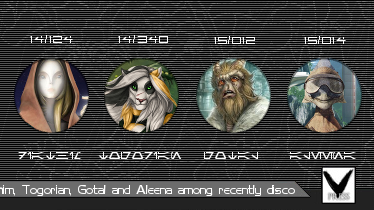CARTOGRAPHY IN AN AGE OF DISCOVERY
Posted by Lord Mustafa on Year 15 Day 33
Onboard the Namana-class Light Cruiser Malfeas in system Lorell (136, 99).
Veritas News Inc. -- Lorell, Hapes Cluster
CARTOGRAPHY IN AN AGE OF DISCOVERY
With the unprecedentedly quickfire discoveries of the Togarian, Gotal and Aleena over recent weeks, and prior to this the increased exploration in uncharted space generally (leading to the discoveries of other races and systems, notably the Diathim), one would think that the cartography industry would be booming. Notions might turn to countless explorers hoping to hit the jackpot, all needing maps; usually digital ones but sometimes, in especially obscure regions of space, physical sector maps. Any explorer of worth would tell you that to have even the remotest chance of success one has to find a safe path through the hyperlanes wherever the desire to search may take. What they require are coordinates.
In reality, cartographers across the Galaxy are finding themselves jobless; their profession challenged by a new, automated system which allows aspiring explorers to calculate coordinates much more quickly and thoroughly than the maps of old. The technology, developed by trading company LBX Holdings, has swiftly seen widespread use as it threatens to displace all previous methods of pathfinding.
Our science correspondent Adame Skamlon has interviewed two men instrumental in the introduction of the new tech; LBX leaders President Kraton Xel and CEO Rennoit LeBeau.
AS: So Kraton, how did you create this new mapping system? Surely toppling an entire industry was no small task.
KX: The majority of the labor was handled by the head of our Technology Division and CEO, Rennoit LeBeau. As is the case with many of our new research and development, we spent hours developing a new method; I provided the more conceptual assistance, while Rennoit did the heavy lifting of the development itself.
AS: New systems are being discovered all the time. Do you know or suspect whether your technology was used in a successful find?
KX: Systems are much harder to detect, but the demand for sector maps has been rising as more and more groups and individuals are attempting to find their own new system. I don't think the need for sector maps will ever really end, as we expect new systems to continue to develop as time passes, as well. Most people try to stay within the boundaries of a sector during their searches, which is what makes this kind of cartography so important.
AS: How do you react to claims that the new system represents a supposed monopolization of the cartography sector? While a small industry, cartography has been a stable area of economies everywhere for thousands of years. Could the cartography companies ever come up with something good enough to challenge your tech?
KX: Just because something has been around for a long time, doesn't mean we shouldn't look for ways to improve upon it, even if that means replacing it entirely. LBX is devoted to our mission of improving processes around the galaxy, and cartography was one where we identified a solution.
This development was not however directed against the professionals of the industry, but rather at making the service more affordable and available.
Mr. LeBeau was only available for comment via Capital Communications Corporation's message network.
AS: Rennoit - how does your system work, exactly? Analysts have been lauding its complexity for months now with no specific indication as to how the tech operates.
RL: It's not overly complicated though it did require writing an algorithm that checked a range of deep space grids against a list of coordinates for any given sector. Once I had the list of coordinates that make up each sector, it was just a matter of looping through them to generate a layout that could serve as a suitable map.
AS: Why did LBX decide to release the technology to the public so early? The system could easily be used to gain an edge in exploring uncharted space, an increasingly frequent and profitable business.
RL: That's a good question. It certainly could have been more profitable to hoard the tech and use it strictly for our own benefit but that's not what LBX is about. We're trying to improve the galaxy over all with our products whether it is through quickly produced and affordable sector maps, our scan processor - SYSNET, or some of the other things we have in the works such as our gaming portal that will revolutionize gambling in the galaxy. I can't really say anything else about that though.
The breakthrough comes as exploration continues to grow in popularity among spacefarers. Discoveries have been so common that many now believe finding new space is an easy feat, with astronomers confounded at the sudden spike in new rocks, planets and even sentient species, ones long thought lost to the Galaxy, being found on what has recently become an almost weekly basis.
Several cults have claimed that the phenomenon signals the beginning of galactic apocalypse; others fear the exploitation of new real estate by governments and private corporations. Still more are trying to find an explanation, citing new technology similar to LBX's development and fresh interest in acquiring new governmental assets as reasons to spark a new age of discovery.
Though nobody truly knows yet why exploration is becoming increasingly successful, the pilots themselves often simply do not care - after all, it's a lucrative business. One thing is clear though: that the galactic economy is adapting to this new situation, starting with the improved technologies being spearheaded by LBX Holdings.


